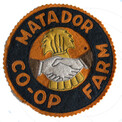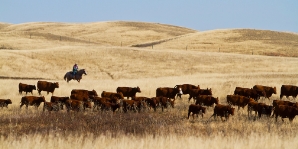Building Matador

The Beginnings
The formation of the Matador Co-op Farm was finalized early in 1946. Nineteen members signed up initially but this number was reduced to seventeen when they started arriving in April, 1946. Family names of the members included Bailey, Barlow, Bishop, Cook, Davis, Dietrick, Goldbeck, Hamilton, Heath, Howes, Lacey, Lilburn, McClelland, Monson, O'Hara, Tone, Walker, and Zazelenchuk.
The Location:
An advance party of seven left Regina on April 9 to commence operations, while the remaining men arrived at Matador within the next two or three weeks. When the first group of veterans arrived at the Matador, they were greeted by nothing but miles upon miles of rolling prairie. This land was native prairie and had always been used for cattle ranching. In early years, thousands of cattle roamed the area on large ranches. Despite the fact the rich soil had never been cultivated, there were no trees of any note. They scouted the area for a suitable location. They would have to build homes, shops, grain storage and barns. The site they chose was close to the Ducks Unlimited dam. There were no roads within five miles of the building site location chosen by the veterans and no power lines either. It was like homesteading in a new land.
Getting Started
The first order of business was to find suitable accommodations for the new members. They were able to obtain a bunk car and a cook car from the experimental farm in Swift Current. This would be their home for the next several months. The next step was to start building homes and/or accommodations for themselves. It was decided that married men would receive individual homes and the single men would live in a dormitory. Spring came early in 1946 and by April, the new members started construction of the Matador Co-op Farm.
With the end of the Second World War in 1945, the St. Aldwyn’s Air Force Base at Swift current was abandoned by the federal government. All the assets of St. Aldwyn’s were put up for sale. The members decided to acquire several of the buildings and convert them into houses and possibly dormitories or other buildings. The members split up into three gangs of men, with one group dismantling the buildings at St. Aldwyn’s, another group would be constructing the homes from these buildings, and the third group would start breaking some of the land in the hopes of getting a crop in that year.
Dismantling the buildings consisted of splitting the buildings into sections small enough so they could be transported across the ferry at the Saskatchewan River Landing. It was tedious work, with long hours. Everything had to done by hand as power tools were not yet available. Crews usually worked from sunrise to sunset.
My parents, Jack and Jessie McClelland were one of the first to arrive. There was literally nothing there except for a bunk car and a cook car. Initially, Mom and Dad did all the cooking for the men. Several buildings were constructed at this first site located near the Ducks Unlimited dam. However, the water quality from the dam was not acceptable so all the buildings were moved south west to it's current location. This would allow access to a fresh water spring just north of the farm.
In August, they began the task of moving all the buildings to a new site, located approximately a half mile southwest of the dam. The houses were built on lots which formed the shape of a horseshoe, with each lot one acre in size. The bottom or U of the horseshoe faced east. The west was left open as that is where the municipal road would come in. The middle of the horseshoe contained a large playground and near the west end, a community hall was constructed. In 1954, the Laidley Springs School and teacherage were moved to the farm. It was located just to the west of our last house, which was the first one on the south side of the horse shoe. Our first home was located on the east end of the horseshoe, very close to the ice house.
I can remember the wood cook stove and ice box fridge. It was almost a daily routine to get a block of ice from the ice house and then split it so it fit in the fridge. The ice was insulated with coarse saw dust so it didn't melt in the ice house. Once the ice was split, you had to wash off the sawdust before putting it in the top compartment of the ice box. I don't remember how long a block lasted, but probably not more that two or three days. There was also a large slough immediately east of the farm. I believe this was drained in later years to be used as farm land. I can recall that a drainage ditch was constructed going south from the farm. I do remember that they used dynamite for blasting the ditch and then a dragline to remove the material.
The electrification of rural Saskatchewan was in its infancy and there were no transmission lines nearby. A large generator was later set up in a building which would supply limited power to the homes. Electric refrigerators were just coming into vogue at that time and ice boxes were the norm.
Ploughing the native prairie was done on a 24-hour per day basis with three caterpillar tractors. They managed to break over 2,500 acres of land by the end of the summer. By mid June they had 320 acres ready for seeding and they had hoped to seed some flax but as there was little rain up to then. They dropped the idea of seeding any more crops and continued with other work.
Life was not easy, hard work and perseverance were the norm. Things improved dramatically with time.
In the early years, crop production varied considerably as it was weather dependant. The early 1950's were years of bountiful harvests, and they had so much crop that much of it had to be stored in piles outside. In 1953, they undertook to build several very large granaries to store all this grain. The over abundance of grain forced the Matador to diversify into livestock, a move made easier by the large pool of labour available on a co-operatively run farm. For several years Matador was a thriving community, with its own school and co-operative store.
I can’t remember exactly when we moved into our second house but it would have been around 1952. It was quite an upgrade from the first home as it was constructed of cinderblocks, had three bedrooms and a bathroom, and a full basement. We still did not have running water or a flush toilet. That would come a few years later. However, it was not a very warm home as there was no insulation in the cinderblocks. It had a large gravity furnace which was fueled by some wood, but mostly coal. The one convenience was a propane kitchen range, a major change from the wood cook stove.
In the first years, children attended the Latham District School, which was about seven miles from the Matador. There were no school buses so students had to be driven to school. In the first winters, they used a sleigh.
I attended school at the Matador. The Laidley Springs School was purchased and moved to the farm. It was a one room school, heated with a wood and/or coal burning stove. There was no running water. The toilets were in the basement and were the standard toilet seat over a pail, which had to be carried out and disposed of in the outhouses. My first teacher was a Miss Baker, who taught all grades from 1 to 6. The school remained in use until 1966. After grade six, you had to take the school bus to Kyle to attend school. What a change, each grade had their own room and teacher, along with running water and real bathrooms. I think it was around 1958 when the Matador ran a water line from the spring located in the hills north of the farm down to the farm. It would supply water to all the homes, a step into the modern era.
Over the years, many more farm buildings were constructed. A large barn was constructed just north of the houses, as well as a dairy barn. Machine sheds were constructed on the south side of the farm and granaries to the west.
The farm was located on the edge of the Missouri Coteau. This a large area of uplands that runs from west central Saskatchewan and down into North and South Dakota. The farm is located just along the south edge of the hills. As a child growing up here, the hills seemed like mountains. In reality, the hills are about 150 feet higher than the flat lands to the south. The hills were very steep and contained many alkali lakes and springs. Some hills were steep enough that livestock would not venture on many of them. Remnants of bald head eagle nests could be found on the sides of these hills. As a young boy, it was an adventurous place to play. There were several open sand pits that provided hours of fun looking for arrow heads, long lost from when the Indigenous people who roamed this land. Growing up there was never boring as there was always something adventurous to do. I was also a member of the Kyle 4-H Club and raised my own calf. After almost a year, it came time to sell my now grown steer in Swift Current at the annual exhibition. The steer was sold at premium rates and I received about $420, which was a lot of money at that time. However, by the time I paid for the calf and feed, I was left with about $60. I promptly bought a new three speed bicycle, which was the envy of many. I was also an aspiring cub/scout.
Winters were equally as fun. I remember walking out to the slough near the farm to go skating. Many a time I returned home unable to feel my feet. It was a very painful experience as your feet warmed up, but we would do it all over again the next day.
Our family's connection to the Matador ended in December 1959. Dad sold his share in the farm and we moved north to Bruno, Saskatchewan, where he had purchased a hardware store. Another dramatic challenge in life for my parents, but Dad finally achieved his dream of being an independent and successful businessman. Mom worked full-time in the store in addition to being a full-time mom. I spent much of my youth working in the store as well. Brother Ken lived in Bruno for a brief time but left to work for SaskTel. Sister Gail graduated from Bruno Central High and went to Saskatoon Business College.

